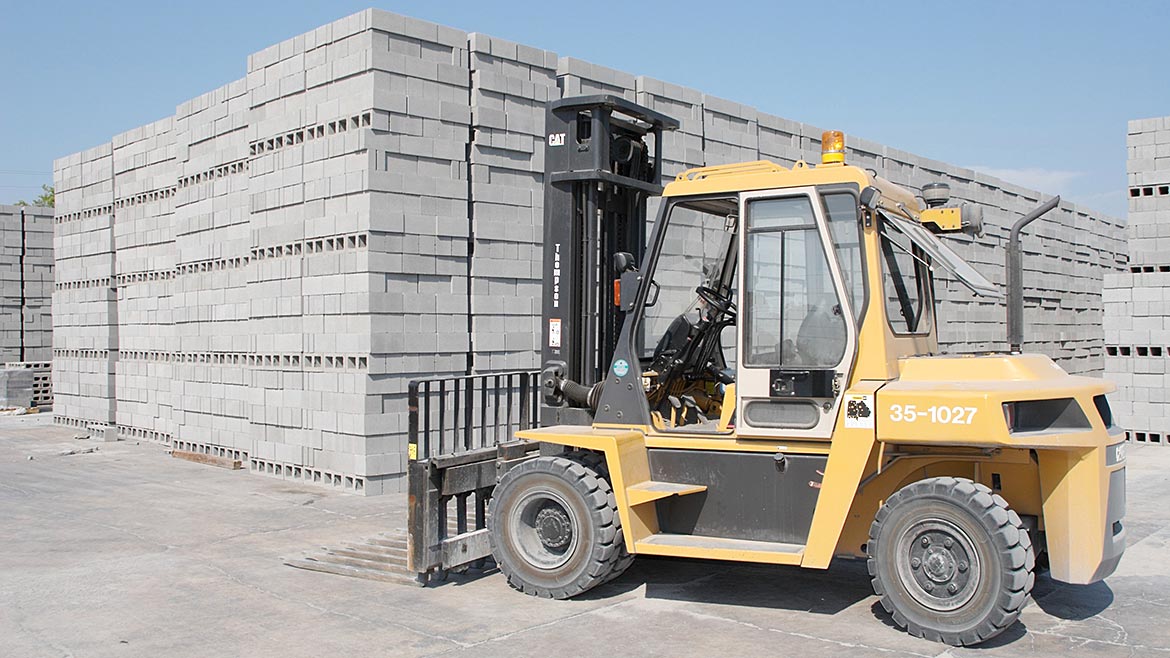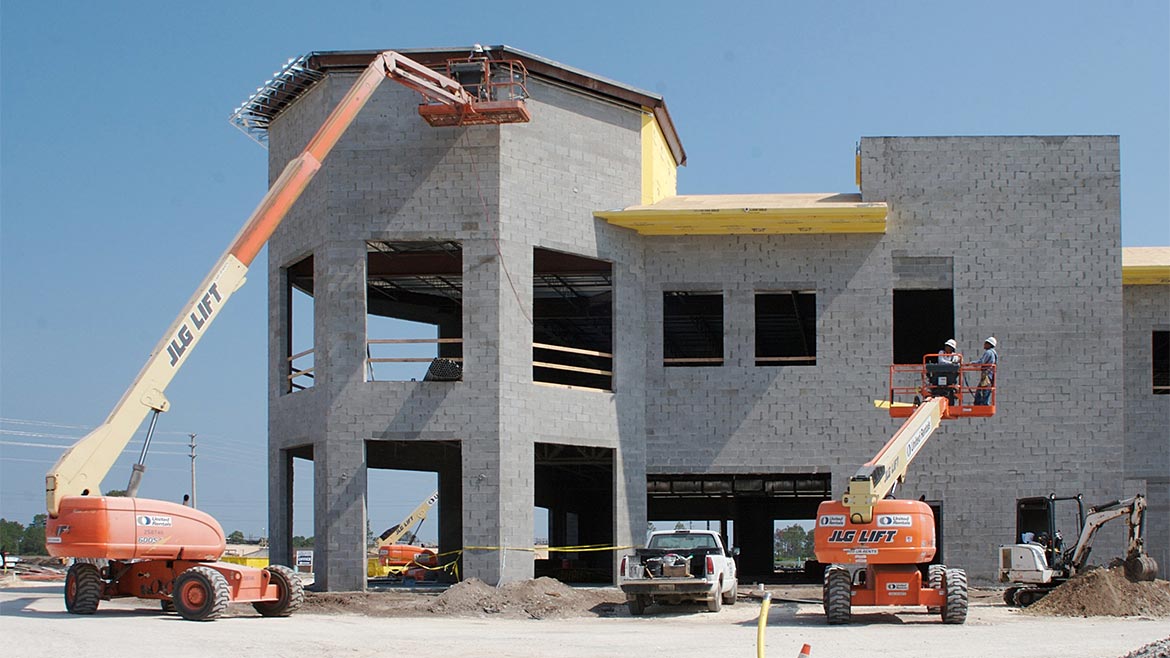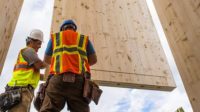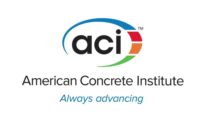Concrete masonry units (aka concrete block or cinder block) arrived on construction sites well over a century ago. Able to withstand rot and pests, these products help create wall systems that are low-maintenance, durable, structurally sound, save energy and sequester carbon. Since their introduction, CMUs have seen several advances in their design, which has helped them keep pace with the increasing demand for high-performing construction materials and wall systems.
One such advancement was the incorporation of lightweight aggregate, which made the concrete, as the term implies, lighter in weight. For many people, lighter also implies weaker. However, this is not the case with lightweight CMUs nor with typical structural lightweight concretes used in high-rise buildings, bridges and offshore oil platforms.
Today, lightweight CMUs use an optimum concrete mixture containing 65 to 70 percent expanded shale, clay and slate lightweight aggregate by volume. The result is a high strength-to-weight ratio that exceeds ASTM’s minimum 2,000-psi strength requirement. However, lightweight CMU’s benefits go beyond strength-to-weight ratios to include increased resilience to seismic activity, better fire resistance, enhanced energy efficiency, faster installation and even newly found carbon sequestration properties.

Sequester More Carbon
All concrete sequesters atmospheric carbon through a well-known process called “carbonation.” Relying on the protocols outlined in the ASTM STP 1640.2022 standards, recent research conducted by the National Concrete Masonry Association indicates dry-cast concrete sequesters an average of 1.30 pounds per cubic foot, a significantly higher quantity than wet-cast concrete. While testing is still underway to determine the long-term characteristics of dry-cast concrete, the research suggests that the relatively “porous” concrete in dry-cast CMUs (either lightweight or normal weight) sequesters more carbon more rapidly than wet-cast and less “porous” regular concrete.
Improve Seismic Performance
Due to the law of inertia, a lighter building will need less force to stop its motion during an earthquake than a heavier one. By specifying lighter materials throughout an entire building (exterior walls included), architects and engineers can reduce a building’s dead load to create more seismically resilient structures.
Lightweight concrete reduces the overall weight of a structure. As such, it mitigates the forces acting on a structure during a seismic event. Additionally, because the concrete is lighter, the other structural components, like steel reinforcing bars, columns and beams, can be smaller to further reduce seismic loads without compromising strength. For example, a bridge near the Green Valley Fault in the San Francisco area used structural lightweight concrete that weighed 15 percent less than normal weight concrete to improve its seismic resilience.
Lightweight CMUs made from ESCS lightweight aggregate can weigh 40 percent less than normal weight units (22 pounds compared to 36 pounds). This can significantly reduce a structure’s dead load and thereby contribute to greater seismic resilience.

Increase Fire Resistance
Like other structural lightweight concretes, CMU made from ESCS deliver improved fire resistance ratings compared to normal weight units. Lightweight concrete transmits heat at a slower rate than traditional concrete due, in part, to the unconnected voids within the ESCS lightweight aggregates. In addition, because ESCS has already been fired at 2,000 degrees Fahrenheit during the manufacturing process, they and the concrete they are a part of retain more compressive strength after fire exposure. Normal weight concrete, on the other hand, tends to lose some of its compressive strength after exposure.
This is incredibly important given that CMUs can be specified for load-bearing firewalls. Retaining their strength at extreme temperatures, units made from ESCS lightweight aggregate mitigate the dangers of collapse during fires, which improves occupant safety. While an extreme example, the Chesterfield County, Va., Fire Training Center demonstrates the long-lasting fire safety lightweight CMUs provides. Having undergone 6,000 fires and hose streams over the course of 25 years, the center’s burn building, which was made from lightweight CMUs containing ESCS aggregates, remains standing. It was even found to be in “excellent shape” when inspected after 15 and 25 years of use.
Be More Energy-Efficient
Lightweight CMU has excellent thermal properties, driven largely by the non-interconnected voids within the ESCS particles themselves. ESCS is a proven insulator. In northern Europe, many building foundations are backfilled with ESCS lightweight aggregate instead of native soil or normal aggregate. This improved thermal performance is well documented in American Concrete Institute and The Masonry Society 122 R-14, Guide to Thermal Properties of Concrete and Masonry Systems.
Concrete, in general, responds slower to changes in outdoor air temperatures and stores thermal energy, unlike framed wall systems. This is known as the “thermal mass effect” and it allows HVAC systems to be sized smaller while still providing comfortable interior temperatures. Smaller HVAC equipment operating for shorter durations saves energy. Lightweight CMUs have an even lower thermal conductivity than comparable normal weight units.
The thermal performance can be improved when using insulated lightweight CMUs. For example, a 12-inch lightweight CMU filled with aminoplast foam provides equal (or better, depending on the climate zone) thermal performance than an R-19 batt-insulated metal stud frame wall.
It is also important to note that delivery efficiencies are easily achieved when using lightweight CMUs. More CMUs can be loaded per truck, which leads to fewer deliveries and less fossil fuel use. Because lightweight CMUs are easier to install and handle, buildings go up quicker. Moreover, masons’ longevity and health is improved.
Lower the Density and Raise the Standards
Lightweight CMUs provide a range of benefits. Engineers, architects and owners alike appreciate the newly recognized carbon sequestration properties of dry-cast CMUs, but they increasingly rely on the improved structural, seismic, fire and thermal properties lightweight CMU offer. Perhaps most of all, the masons or contractors installing them appreciate that they are lighter, easier and quicker to install.






Report Abusive Comment